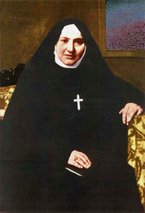
After her recovery, she left her village due to the financial situation of her family and, surely not by chance, entered into domestic service, first with Rev. G. B. Rota, parish priest of Chiari, who a few years later was to become the Bishop of Lodi, and afterwards with the Countess Fé-Vitali. These meetings and experiences were to be very important to Caterina. During the Christmas season of 1876 she reaffirmed her dedication to Jesus and wrote a very demanding way of conducting her life, to which she remained faithful.
On the Feast of Corpus Christi of 1878, with the permission of her confessor, she made the vow of chastity, which she had made on the morning of her secret Comunion, perpetual. Without neglecting her duties as a domestic servant, Caterina decided to educate the children of San Gervasio, Bergamo, guiding them towards an honest life of christian and social virtues.
By means of assiduous prayer, mortification, an intense interior life and the practice of the deeds of charity, Caterina prepared herself to accept the will of the Lord. Freed from family responsibilities after her parents’ death, the young woman sought a way to achieve her Eucharistic ideal.
She opened her heart to the Bishop of Bergamo Mgr Speranza, who was, at that time, in Bienno as a guest of the Fé-Vitali’s. He encouraged and assured her that her plans were the will of God.
In 1880, while in Rome with the Fé-Vitali’s, she succeeded in speaking with Pope Leo XIII about her plans to establish a religious institute devoted to the adoration of the Eucharist. The Pope changed them by inviting her to include the education of young female factory workers as well.
Supported by the new Bishop of Bergamo, Mgr Guindani, and by her “Father and Superior”, Rev. F. Spinelli, on December 15, 1882, Caterina, together with two of her friends began the Congregation of the Sacramentine Sisters of Bergamo with the first adoration hour of the Blessed Sacrament. On December 15, 1884 she took the name of Sister Geltrude of the Blessed Sacrament.
The new Congregation revealed itself to be God’s work. In fact, like all God’s work, it endured many adversities which sorely tried the “tender little plant”. However, this plant had already spread its deep roots into the rich soil of prayer, mortification and humility. It mattered little that Sister Geltrude and her Sisters, advised by the Bishop of Bergamo, Mgr Camillo Guindani, successor to Mgr Speranza, had to abandon their first “nest” in order to take refuge in Lodi. Mgr Rota, Bishop of Lodi, welcomed them and generously gave them a house in Lavagna di Comazzo, which temporarily became the Mother House of the Institute.
When innumerable difficulties had been overcome, Mgr Rota, with the Decree of September 8, 1891, gave canonical recognition to the Institute. On March 28, 1892, Mother Geltrude returned to Bergamo, the birthplace of the Congregation. There she gave it decisive and strong direction. God’s work was fulfilled!
The Foundress had guaranteed by then the continuation of the perpetual and public adoration of Jesus in the Blessed Sacrament and had instilled her precious ideas into her Sisters. Hers was a spirit of prayer, sacrifice, mortification, obedience, humility and charity mainly towards the poor. Therefore, she could approach her godly Bridegroom. On February 18, 1903, at midday, Mother Geltrude, bowing her head towards the Church of Adoration, began her eternal adoration. The news of her death quickly spread. Those who had known her, especially the poor and the humble, who were her favourite people, declared her a saint. On August 9, 1926, her venerable remains were taken from the cemetery of Bergamo to the Mother House of the Institute which she had established. There she lies in a special chapel next to the Church of Adoration.
By request of numerous people, on February 18, 1928, the Ordinary Process on the reputation of Mother Geltrude’s sanctity, her virtuous life as well as miracles, granted by God through Mother Geltrude’s intercession, began. It ended in 1939.
In the same year, Pius XII authorized the preliminary investigation of the Apostolic Process in the Cause of Mother Geltrude.
On April 26, 1961, the General Congregation of the then Congregation of Sacred Rites was held in the presence of Pope John XXIII. His Holiness promulgated the Decree on the heroic virtuous life experienced by Mother Geltrude Comensoli, who was then given the title of “Venerable”.
On October 1, 1989, Pope John Paul II declared her a Blessed Soul.
On April 26, 2009 Pope Benedict XVI entered her on the register of Saints.
Taken from the Vatican Website http://www.vatican.va

 RSS Feed
RSS Feed
